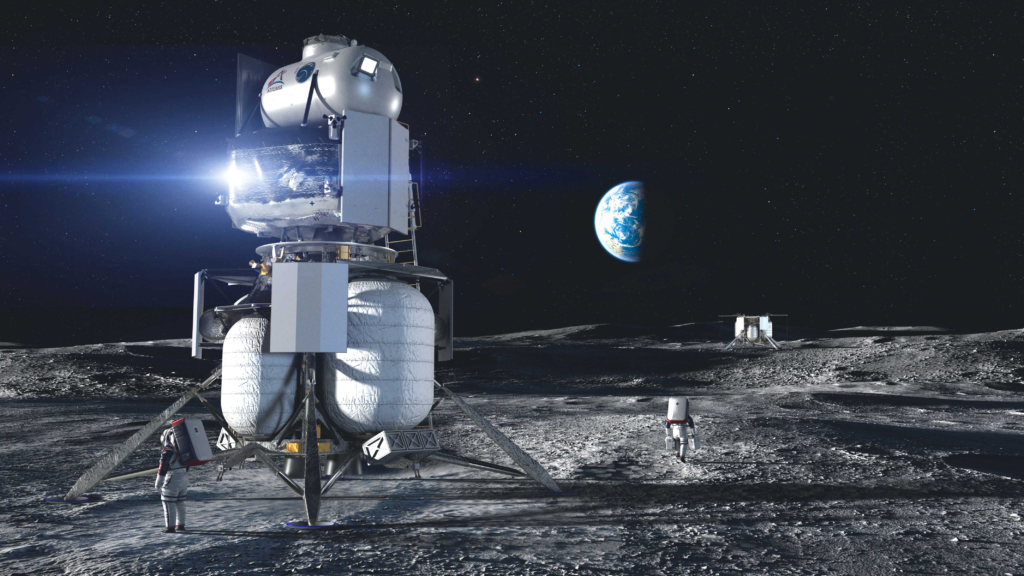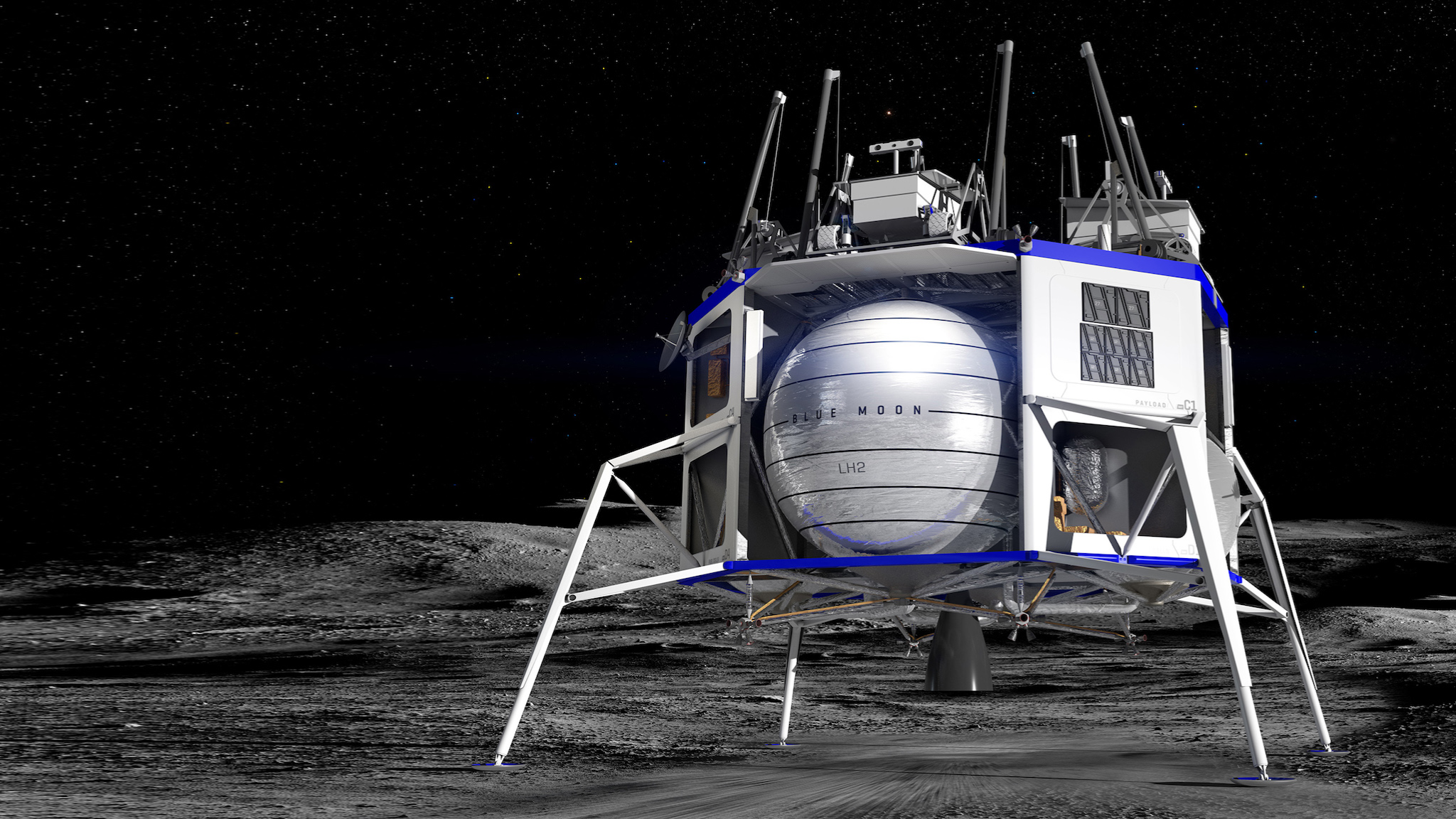
What Happened To Blue Origin’s Lunar Lander?
It has been quite a while since the last time we heard about Blue Origin’s Lunar Lander. This brings up the question of what exactly is its plan and has Blue Origin been working on the project. As we know, right now NASA is trying to return humans to the Moon for good apart of Artemis. Some of these first significant steps include launching the Space Launch System which is set to happen not long from now. However, in the future, humans will need a lander in order to access the surface.
This is where a lunar lander comes into play in the form of a commercial option. Unfortunately for Blue Origin, last year NASA ended up picking SpaceX as the sole provider for a Moon Human Landing System. However, most recently, the agency announced additional opportunities past some of the first planned missions where additional options were being considered.
With this in mind, Blue Origin has a possible future in this field with Blue Moon. This being said, NASA shared quite a few reasons why this specific lander was not originally picked. All of which comes in addition to whether or not progress is being made on different aspects of Blue Moon. Here I will go more in-depth into its future opportunities, progress on the lander, its engine, and more.
Any Blue Moon News?

Blue Moon is a lunar lander meant to deliver a wide variety of small, medium, and large payloads to the lunar surface. Blue Origin is confident that its capability to provide precise and soft landings will enable a sustained human presence on the Moon. In terms of progress, the company has not released any new information in quite a long time. One of the main components of this lunar lander is the single engine BE-7 engine developed by Blue Origin. BE-7 is an additively manufactured, high-performance, dual-expander cycle engine, generating 40 kN (10,000 lbf) thrust. The company points out they are maturing the design, manufacturing hardware, and have begun hot firing the engine.
Taking a closer look at BE-7, one of the last big updates on it came in December, 2020. Here Blue Origin reported on some of the test results and it’s application to the lunar lander. During the test campaign, the thrust chamber was tested for a duration of 20 seconds. This brought the cumulative testing time on the BE-7 thrust chamber to 1,245 seconds. At the time, Brent Sherwood, vice president, of Advanced Development Programs, said, “The BE-7, a turbomachinery-based engine using the most efficient propellants, is optimal for deep-space maneuvers and landing on the Moon. Our engine test series is steadily maturing what’s needed to get Americans safely on the lunar surface as soon as possible. We are positioning to use the Moon’s ice resources for rocket propellant, which will make exploration sustainable and open the Moon for commerce.” In addition to this, in March of this year, Blue Origin tweeted saying, “Earlier this year, Blue Origin’s #BE7 lunar lander engines program completed another successful Thrust Chamber Assembly hotfire test campaign at @NASA_Marshall. To date, the campaign has completed a total of 92 tests for 3,347 cumulative seconds of hotfire.” Going forward the success of this engine will have a direct impact on a Blue Origin lunar lander. This especially is the case within the National Team’s Human Landing System architecture, where BE-7 is used on both the Descent Element and Transfer Element.
Other than this, some of the main news came in the form of NASA’s new lunar lander opportunity and a second chance for Blue Origin. In March of this year, the agency announced plans to create additional opportunities for commercial companies to develop an astronaut Moon lander. Under this new approach, NASA is asking American companies to propose lander concepts capable of ferrying astronauts between lunar orbit and the lunar surface for missions beyond Artemis III, which will land the first astronauts on the Moon in more than 50 years. Built and operated according to NASA’s long-term requirements at the Moon, new landers will have the capability to dock to a lunar orbiting space station known as Gateway, increase crew capacity, and transport more science and technology to the surface. “Under Artemis, NASA will carry out a series of groundbreaking missions on and around the Moon to prepare for the next giant leap for humanity: a crewed mission to Mars,” said NASA Administrator Bill Nelson. “Competition is critical to our success on the lunar surface and beyond, ensuring we have the capability to carry out a cadence of missions over the next decade.” While Blue Origin may have originally lost hope after the lost contract and lawsuits, they are not out of the race yet.
Blue Moon Overview & Timeline

Now that we know more about the current state of Blue Moon and its possible future, we can take a closer look at the lunar lander itself, and how it’s changed over the past few years. Back in December of 2020, the HLS National Team, submitted its option A lunar lander proposal to NASA. Blue Origin leads the Human Landing System (HLS) National Team, which includes Lockheed Martin, Northrop Grumman, and Draper. As many of us know, not long after NASA eventually came out with a decision and picked SpaceX as the sole provider for the initial missions. In the agency’s official report regarding the decision, in a summary evaluation, they described Blue Origin’s technical rating as acceptable and management rating as very good. This was in comparison to SpaceX which received an acceptable and outstanding rating.
More specifically, the report was quoted mentioning, “But despite these and other strengths of Blue Origin’s technical design, I find that it suffers from a number of weaknesses, including two significant weaknesses with which I agree. The first of these is that Blue Origin’s propulsion systems for all three of its main HLS elements (Ascent, Descent, and Transfer) create significant development and schedule risks, many of which are inadequately addressed in Blue Origin’s proposal.” This problem along with a few others were some of the reasons NASA did not pick Blue Origin. From here the company filed multiple lawsuits and eventually lost them and moved on.
In order to better understand NASA’s decision and Blue Origin’s future, we can look more closely at Blue Origins’ main contribution and the Blue Moon lunar lander itself. In terms of design and payloads, the top deck and lower bays are meant to accommodate a wide variety of payloads, including large payloads and ESPA-class payloads with standard ring port interfaces. There are lower mounting locations for payloads, useful for closer access to the lunar surface and off-loading. The lander also provides kilowatts of power to payloads using its fuel cells, allowing for long mission durations and the ability to last through the lunar night. For landing, it features precision guidance and descent sensors that utilize machine learning technology to accurately land anywhere on the lunar surface, starting with its first mission. Finally, Blue Origin describes it as versatile, as it hopes to deliver large infrastructure payloads with high accuracy to pre-position systems for future missions. The larger variant of Blue Moon has been designed to land an ascent vehicle, and is a part of the HLS National Team integrated system.
All of which comes back to the second chance and Blue Moon’s future. In April 2021, NASA selected SpaceX as its partner to land the next American astronauts on the lunar surface. That demonstration mission is targeted for no earlier than April 2025. Exercising an option under the original award, NASA now is asking SpaceX to transform the company’s proposed human landing system into a spacecraft that meets the agency’s requirements for recurring services for a second demonstration mission. Pursuing more development work under the original contract maximizes NASA’s investment and partnership with SpaceX. The upcoming second contract award, known as the Sustaining Lunar Development contract, combined with the second option under SpaceX’s original landing award, is meant to pave the way for future recurring lunar transportation services for astronauts at the Moon. “This strategy expedites progress toward a long-term, sustaining lander capability as early as the 2026 or 2027 timeframe,” said Lisa Watson-Morgan, program manager for the Human Landing System Program at NASA’s Marshall Space Flight Center in Huntsville, Alabama. “We expect to have two companies safely carry astronauts in their landers to the surface of the Moon under NASA’s guidance before we ask for services, which could result in multiple experienced providers in the market.” As time goes on, we will have to watch Blue Origin’s progress and whether or not Blue Moon ends up going to the Moon apart of Artemis and other future missions.
Conclusion
Blue Origin has been working on a lunar lander for quite a while now. Unfortunately for the company, after missing out on a significant contract with NASA last year, the future of Blue Moon was questionable. Despite this, they have been continuing to work on different components such as the BE-7 engine and more. With a new opportunity to provide lander services through Artemis, there is hope for Blue Moon. We will have to wait and see how it progresses and the impact it has on the space industry.
